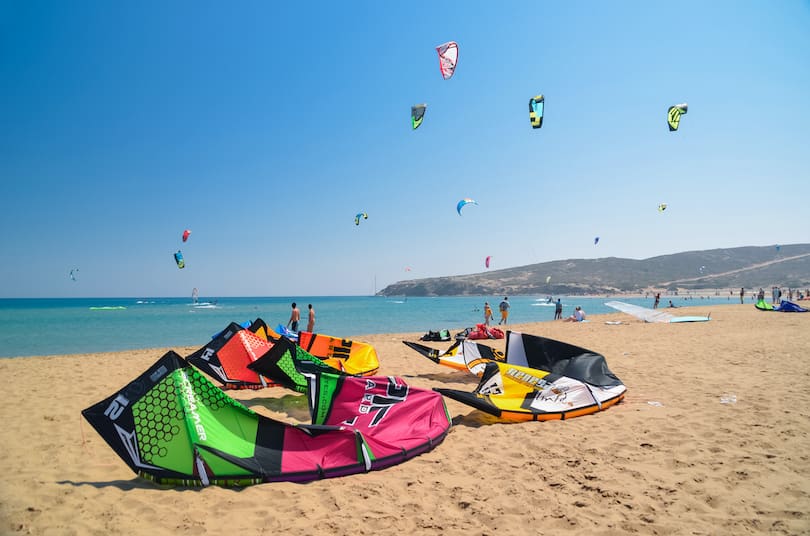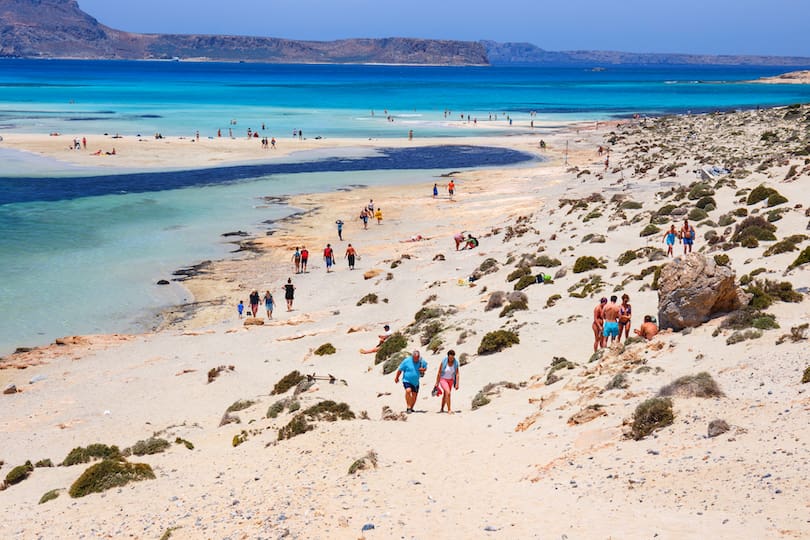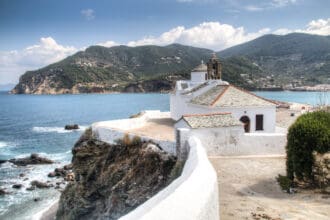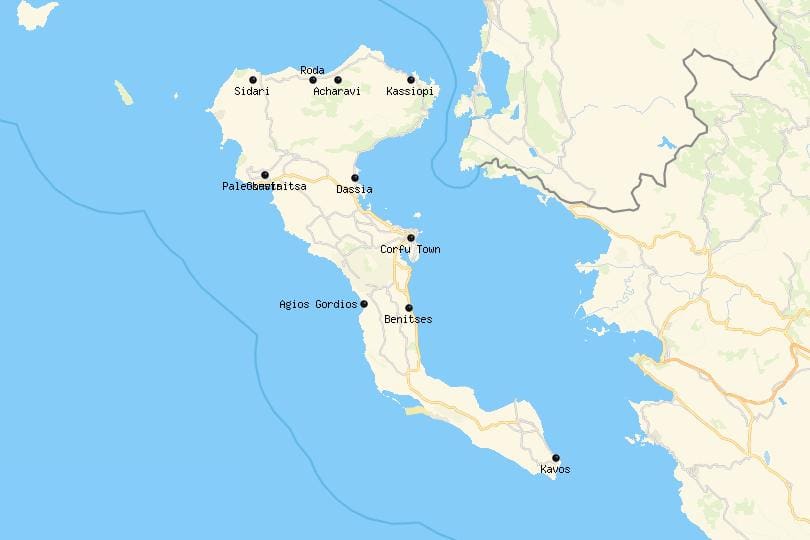Rhodes, the largest of the Dodecanese islands in Greece, is a destination that effortlessly blends history, culture, and natural beauty. Whether you’re a history enthusiast, a sun-seeker, or an adventurer, this island has something for everyone. In this comprehensive guide, we’ll explore the 17 top attractions and things to do in Rhodes , ensuring you make the most of your visit. From ancient ruins to pristine beaches, vibrant nightlife, and local culinary delights, Rhodes offers a unique experience that captivates travelers from around the world.
Discovering the Medieval City of Rhodes: A UNESCO World Heritage Site
The Medieval City of Rhodes is one of the most iconic landmarks on the island and a must-visit destination for anyone exploring Greece. As a UNESCO World Heritage Site , it stands as a testament to the island’s rich history and architectural brilliance. The city is divided into two distinct sections: the Upper Town (Collachium) and the Lower Town (Chora).
Exploring the Upper Town
The Upper Town was historically reserved for knights and nobility. Here, you’ll find the Palace of the Grand Master , a stunning fortress that served as the residence of the Knights Hospitaller during the medieval period. This imposing structure houses a museum with artifacts ranging from ancient Greek sculptures to Byzantine relics. Walking through its grand halls, you’ll feel transported back to a time of chivalry and conquest.
The Palace of the Grand Master itself is a masterpiece of Gothic architecture. Its massive stone walls rise dramatically above the surrounding landscape, creating an imposing silhouette against the sky. Inside, visitors can explore numerous chambers filled with historical treasures. One notable exhibit features intricate mosaics from the Hellenistic era, showcasing the artistic achievements of ancient civilizations. Another highlight is the Throne Room, where the Grand Master would hold court, adorned with elaborate tapestries and ornate furnishings.
Beyond the palace, the Upper Town boasts several other significant landmarks. The Hospital of the Knights , for instance, is another remarkable building within the walled city. Originally constructed to care for sick and injured knights, it now serves as a museum displaying medical instruments and documents from the medieval period. Visitors can also stroll along the fortified walls, which offer breathtaking views of the Aegean Sea and the modern city below.
Strolling Through the Lower Town
In contrast, the Lower Town is a maze of narrow cobblestone streets lined with charming shops, cafes, and traditional Greek tavernas. Don’t miss the Street of the Knights , where each building represents a different national order of knights. This street is a photographer’s dream, offering a glimpse into the past with its well-preserved architecture.
As you wander through the Lower Town, you’ll encounter numerous small squares and hidden courtyards, each with its own character and charm. Many of these spaces host outdoor markets and festivals throughout the year, providing opportunities to interact with locals and sample authentic Greek products. For example, the Sokratous Street Market is a bustling hub of activity, selling everything from fresh produce and spices to handmade jewelry and textiles.
One cannot overlook the importance of the Mosque of Suleiman the Magnificent in the Lower Town. Built during the Ottoman occupation, this mosque reflects the diverse cultural influences that have shaped Rhodes over the centuries. Although no longer used for religious purposes, it remains an important historical landmark and occasionally hosts cultural events.
Travel Tip: Wear comfortable shoes when exploring the Medieval City, as the cobblestone streets can be uneven and challenging to navigate in heels or sandals.
The Acropolis of Lindos: A Journey Through Time
Perched atop a rocky hill overlooking the azure Aegean Sea, the Acropolis of Lindos is another highlight of Rhodes. This ancient site combines elements of Greek, Roman, and Byzantine architecture, making it a fascinating destination for history buffs.
Key Features of the Acropolis
The centerpiece of the Acropolis is the Temple of Athena Lindia , dedicated to the goddess Athena. Although much of the temple lies in ruins today, its Doric columns and intricate carvings still evoke a sense of awe. Nearby, you’ll find the remains of a Hellenistic stoa, a Roman theater, and a Byzantine church, showcasing the diverse cultural influences that have shaped the region over centuries.
Visitors often begin their exploration at the base of the hill, where they can admire the impressive Propylaea , the monumental gateway leading up to the Acropolis. These gates were designed to impress and intimidate, serving both ceremonial and defensive functions. As you ascend the steep path, you’ll pass by remnants of ancient fortifications, including watchtowers and bastions that once protected the sacred site.
Once at the summit, the panoramic views are nothing short of spectacular. On clear days, you can see all the way to the neighboring islands of Symi and Halki. The combination of natural beauty and historical significance makes the Acropolis of Lindos a truly unforgettable experience.
Lindos Village: A Picturesque Setting
After exploring the Acropolis, take some time to wander through Lindos Village , located at the base of the hill. This whitewashed settlement is known for its traditional houses, vibrant bougainvillea, and panoramic views of the coastline. Enjoy a leisurely meal at one of the rooftop restaurants, where you can savor fresh seafood while admiring the sunset.
Lindos Village exudes a timeless charm, with narrow alleys winding between quaint cottages and elegant mansions. Many of these buildings date back to the Venetian and Ottoman periods, reflecting the town’s rich architectural heritage. Artisans and craftsmen continue to practice their trades here, creating beautiful ceramics, textiles, and jewelry inspired by local traditions.
For those interested in maritime history, the Lindos Maritime Museum provides fascinating insights into the island’s seafaring past. Exhibits include model ships, navigational instruments, and photographs documenting the evolution of Lindos as a major port and trading center.
Relaxing on Tsambika Beach: A Paradise for Sun Lovers
If you’re looking for a slice of paradise, Tsambika Beach is the perfect spot to unwind. Stretching over a kilometer, this golden-sand beach is renowned for its crystal-clear waters and tranquil atmosphere. It’s an ideal destination for families, couples, and solo travelers alike.
Activities at Tsambika Beach
While relaxation is the main draw, there are plenty of activities to keep you entertained. Rent a sunbed and umbrella to soak up the Mediterranean sun, or try your hand at water sports like jet skiing, paddleboarding, and snorkeling. For those seeking adventure, the nearby Tsambika Monastery offers a rewarding hike with breathtaking views of the coastline.
Tsambika Beach is particularly popular among surfers and windsurfers due to its consistent breezes and favorable conditions. Several schools and rental shops cater to beginners and experienced enthusiasts alike, providing lessons and equipment. Additionally, the shallow waters make it safe for children to play and swim, while lifeguards ensure everyone’s safety.
For a more secluded experience, head to the northern end of the beach, where fewer crowds gather. Here, you can enjoy privacy and tranquility, surrounded by dunes and native vegetation. Picnic areas and shaded spots under palm trees provide convenient places to relax and recharge.
Cultural Significance
Above the beach stands the Tsambika Monastery , a revered pilgrimage site dedicated to the Virgin Mary. According to legend, women who climb the 300 steps to the monastery barefoot will be blessed with fertility. While the ascent may be challenging, the panoramic vistas from the top are well worth the effort.
Travel Tip: Arrive early in the morning to secure a prime spot on the beach, especially during peak tourist season.
Exploring the Valley of the Butterflies: Nature’s Hidden Gem
Located just outside the town of Petaloudes, the Valley of the Butterflies is a serene sanctuary teeming with wildlife. This lush nature reserve is home to thousands of Jersey tiger moths, which flock here every summer to breed.
A Walk Through the Valley
Follow the winding paths that lead through dense vegetation, streams, and waterfalls. Along the way, you’ll encounter wooden bridges, observation decks, and informative signs about the local flora and fauna. Keep your camera ready, as the sight of countless butterflies fluttering around is truly magical.
The valley is part of a larger ecological system that supports a wide variety of plant and animal species. Visitors can observe rare orchids, aromatic herbs, and towering cypress trees, all thriving in the microclimate created by the surrounding hills. Birdwatchers will delight in spotting endemic species such as the Cretzschmar’s bunting and the Eastern olivaceous warbler.
Several designated picnic areas allow visitors to pause and enjoy a meal amidst the natural splendor. Benches and rest stops are strategically placed along the trails, ensuring comfort even for those with limited mobility. Guided tours are available for those who wish to gain deeper insights into the valley’s ecosystem and conservation efforts.
Conservation Efforts
It’s important to note that visitors are encouraged to respect the environment by refraining from loud noises or using flash photography, as these can disturb the delicate ecosystem. Educational programs and workshops aim to raise awareness about the importance of preserving habitats like the Valley of the Butterflies for future generations.
Visiting the Palace of the Grand Master: A Symbol of Power
No trip to Rhodes would be complete without visiting the Palace of the Grand Master , one of the island’s most impressive landmarks. Originally built in the 7th century as a Byzantine citadel, it was later expanded by the Knights Hospitaller in the 14th century.
Inside the Palace
Step inside to discover a treasure trove of historical artifacts, including mosaics, frescoes, and weaponry. The palace’s interior is equally captivating, with its grand staircases, ornate ceilings, and expansive courtyards. Guided tours are available for those who wish to delve deeper into its storied past.
Upon entering the palace, visitors are greeted by a grand hall adorned with exquisite marble floors and towering columns. The Hall of the Knights, once used for banquets and ceremonies, features a magnificent ceiling painted with scenes from mythology and history. Adjacent rooms house collections of armor, weapons, and manuscripts, shedding light on the daily lives and military prowess of the Knights Hospitaller.
One of the most intriguing exhibits is the Archaeological Museum , housed within the palace grounds. Here, visitors can marvel at artifacts spanning thousands of years, from prehistoric tools to classical statues and Byzantine icons. Interactive displays and multimedia presentations enhance the educational value of the museum, making it accessible to audiences of all ages.
Panoramic Views
Climb to the top of the palace for sweeping views of the surrounding area, including the harbor and the modern city of Rhodes. It’s a great spot to capture memorable photos and reflect on the island’s storied history.
From the rooftop terrace, you can see the entire layout of the Medieval City, with its labyrinthine streets and imposing fortifications. Beyond the city walls, the turquoise waters of the Aegean stretch out towards the horizon, dotted with fishing boats and yachts. Sunset is an especially magical time to visit, as the fading light casts a golden glow over the ancient stones.
Experiencing Traditional Greek Cuisine in Rhodes
One of the highlights of any trip to Rhodes is indulging in its culinary delights . Greek cuisine is famous for its fresh ingredients, bold flavors, and hearty portions. From street food to fine dining, there’s no shortage of options to satisfy your taste buds.
Must-Try Dishes
Start your day with a traditional Greek breakfast featuring bougatsa , a sweet pastry filled with creamy custard. For lunch, sample local specialties such as moussaka , souvlaki , and stifado , a slow-cooked beef stew flavored with red wine and spices. Don’t forget to pair your meal with a glass of retsina , a resin-flavored white wine unique to Greece.
Greek cuisine emphasizes seasonal produce and simple preparation methods that let the natural flavors shine. Fresh vegetables, olive oil, lemon juice, and herbs form the foundation of many dishes, resulting in meals that are both nutritious and delicious. Seafood lovers will appreciate the abundance of fish and shellfish caught daily in the Aegean, prepared grilled, fried, or baked with minimal seasoning.
For dessert, indulge in baklava , layers of phyllo dough filled with nuts and honey syrup, or galaktoboureko , a creamy semolina custard wrapped in crispy pastry. Both treats are rich and satisfying, perfect for sharing with friends or family after a long day of sightseeing.
Local Markets
For a more immersive experience, visit one of Rhodes’ bustling markets. The Old Town Market is particularly popular, offering everything from fresh produce to handmade crafts and souvenirs. It’s a great place to interact with locals and learn about their way of life.
Vendors proudly display colorful arrays of fruits, vegetables, cheeses, and meats, inviting customers to sample before purchasing. Spices and dried goods fill the air with enticing aromas, while artisans showcase their skills in weaving, pottery, and metalwork. Bargaining is common in these markets, adding an element of fun and excitement to the shopping experience.
Seven Springs: A Natural Oasis
Nestled in the heart of Rhodes, Seven Springs is a serene retreat that offers a refreshing escape from the hustle and bustle of city life. This lush oasis is surrounded by dense vegetation, cool streams, and towering trees, making it an ideal destination for nature lovers and those seeking tranquility.
Exploring the Springs
The name “Seven Springs” refers to the seven natural springs that feed into a small lake within the park. These springs provide a constant flow of fresh, cool water, creating a microclimate that supports a diverse range of plant and animal species. Visitors can follow well-marked trails that wind through the forest, leading to picturesque spots perfect for picnics and relaxation.
One of the highlights of Seven Springs is the tunnel that runs beneath the hillside. This narrow passageway, carved out of rock, leads to the main lake and offers a unique experience as you emerge into the light to be greeted by the shimmering waters. The tunnel is a popular spot for photography, especially during golden hour when the sunlight filters through the trees, casting dappled shadows on the ground.
Wildlife and Flora
The area around Seven Springs is teeming with wildlife. Birdwatchers will enjoy spotting endemic species such as the Sardinian warbler and the Cretzschmar’s bunting. In addition to birds, the park is home to various reptiles, amphibians, and small mammals. Keep an eye out for lizards sunning themselves on rocks and frogs hopping near the water’s edge.
The flora in Seven Springs is equally impressive. Towering cypress trees provide shade, while aromatic herbs like thyme and oregano fill the air with their distinctive scents. Wildflowers bloom throughout the year, adding bursts of color to the landscape. Springtime is particularly beautiful, with fields of poppies and daisies carpeting the ground.
Activities and Amenities
For those who prefer a more active experience, Seven Springs offers several recreational opportunities. Hiking trails range from easy strolls to more challenging routes, catering to all fitness levels. Mountain biking is another popular activity, with designated paths allowing cyclists to explore the rugged terrain.
Facilities within the park include picnic areas, restrooms, and snack bars. Families will appreciate the playgrounds and shallow pools where children can splash around safely. During the summer months, guided tours and educational programs are available, providing insights into the park’s ecosystem and conservation efforts.
Travel Tip: Bring insect repellent, especially during the warmer months, as mosquitoes can be prevalent near the water sources.
Kallithea Springs: A Historic Spa Complex
Located on the eastern coast of Rhodes, Kallithea Springs is a stunning example of early 20th-century architecture combined with natural beauty. This historic spa complex was once a popular destination for wealthy Europeans seeking therapeutic treatments, and today it remains a beloved landmark.
Architectural Marvels
The buildings at Kallithea Springs were designed by Italian architect Pietro Lombardi in the 1920s. Inspired by Art Deco and Moorish styles, they feature intricate mosaics, domed roofs, and arched doorways. The main pavilion houses a museum showcasing artifacts related to the spa’s history, including photographs, documents, and medical equipment used in treatments.
Visitors can wander through the grand halls and courtyards, marveling at the attention to detail in every aspect of the design. Frescoes depicting mythological scenes adorn the walls, while ornate chandeliers hang from the ceilings. The combination of classical elegance and exotic influences creates a truly unique atmosphere.
Therapeutic Waters
The springs themselves are renowned for their healing properties. Rich in minerals like sulfur and magnesium, the water is believed to alleviate a variety of ailments, from skin conditions to joint pain. While the original spa facilities are no longer operational, visitors can still access the springs via designated bathing areas.
For a more immersive experience, consider booking a session at one of the nearby wellness centers. Many offer modern hydrotherapy treatments inspired by traditional methods, using the mineral-rich water to promote relaxation and rejuvenation. Massages, facials, and body wraps are also available, incorporating locally sourced ingredients like olive oil and honey.
Beach and Surroundings
Adjacent to the spa complex is a beautiful pebble beach, perfect for swimming and sunbathing. The clear waters and gentle waves make it suitable for all ages, and there are plenty of amenities, including sunbeds, umbrellas, and beach bars. Snorkeling enthusiasts will enjoy exploring the underwater world, where colorful fish and coral reefs await discovery.
The surrounding area is dotted with cafes and restaurants serving fresh seafood and traditional Greek dishes. Try the local specialty, kalamarakia (fried squid), paired with a glass of chilled white wine. As the sun sets, the sky transforms into a canvas of vibrant hues, casting a warm glow over the entire scene.
Monolithos Castle: A Medieval Fortress
Perched atop a rocky outcrop overlooking the sea, Monolithos Castle is a testament to the strategic importance of Rhodes throughout history. Built by the Knights Hospitaller in the 15th century, this fortress served as a defensive stronghold against pirate attacks and invasions.
Historical Significance
The castle’s location was chosen for its commanding views of the coastline, allowing defenders to spot approaching ships from miles away. Its thick stone walls and fortified gates were designed to withstand prolonged sieges, and remnants of cannons and battlements can still be seen today.
Inside the castle grounds, visitors will find the ruins of a small chapel dedicated to Saint Panteleimon. Although partially destroyed, the structure retains its charm, with faded frescoes and weathered stones telling stories of devotion and resilience. Archaeological excavations have uncovered various artifacts, including pottery shards and coins, shedding light on the daily lives of those who once inhabited the fortress.
Panoramic Views
Climbing to the top of Monolithos Castle rewards visitors with breathtaking vistas. On one side, the rugged cliffs plunge dramatically into the sea, while on the other, rolling hills and verdant valleys stretch out towards the horizon. The contrast between the harsh, barren landscape and the lush interior is striking, highlighting the island’s diverse geography.
Photographers will find endless inspiration here, whether capturing the interplay of light and shadow on the ancient stones or framing the distant islands silhouetted against the sky. Sunrise and sunset are particularly magical times to visit, as the changing colors enhance the dramatic scenery.
Nearby Attractions
A short drive from Monolithos Castle lies the charming village of Apollona , known for its whitewashed houses and friendly locals. Here, you can sample homemade delicacies like loukoumades (honey-soaked doughnuts) and spoon sweets (fruit preserves). The village square often hosts cultural events and festivals, providing opportunities to immerse yourself in local traditions.
Another nearby attraction is Agios Pavlos Beach , a secluded cove with crystal-clear waters and soft sand. It’s a great spot for snorkeling and diving, with abundant marine life just waiting to be discovered. For the adventurous, hiking trails lead from the beach up to the castle, offering a rewarding challenge with spectacular rewards.
Anthony Quinn Bay: A Secluded Paradise
Named after the legendary actor who fell in love with its beauty, Anthony Quinn Bay is a hidden gem tucked away on the southeastern tip of Rhodes. Known for its turquoise waters and dramatic cliffs, this cove is a favorite among locals and discerning travelers alike.
Natural Beauty
Anthony Quinn Bay is characterized by its steep, rocky shores and crystal-clear waters. The bay is surrounded by jagged cliffs covered in lush vegetation, creating a sense of seclusion and privacy. Sunlight dances across the surface of the sea, creating mesmerizing patterns that change with the tides.
Snorkeling and diving are highly recommended activities here, as the underwater world is incredibly diverse. Coral reefs, sea caves, and shipwrecks provide habitats for a wide array of marine creatures, from octopuses and moray eels to schools of colorful fish. Visibility is excellent, allowing even novice divers to fully appreciate the underwater spectacle.
Access and Facilities
Reaching Anthony Quinn Bay requires a bit of effort, as it is accessible only by boat or a steep path leading down from the road. However, the journey is well worth it, as the isolation ensures minimal crowds and pristine conditions. Once there, you’ll find basic amenities such as sunbeds, umbrellas, and a small snack bar.
For those arriving by boat, organized excursions depart regularly from nearby ports like Faliraki and Lindos. These tours often include stops at other scenic locations along the coast, providing a comprehensive overview of Rhodes’ maritime wonders. Kayaking and paddleboarding are also popular ways to explore the bay, offering a closer connection to the natural environment.
Cultural Connection
Anthony Quinn’s association with the bay adds a layer of intrigue and nostalgia. During the filming of “The Guns of Navarone,” the actor reportedly purchased a piece of land adjacent to the bay, intending to build a villa. Although his plans never materialized, the bay retains his legacy, attracting fans eager to walk in his footsteps.
Local legends speak of hidden treasures buried beneath the cliffs, adding to the mystique of the place. Whether fact or fiction, these tales contribute to the bay’s allure, encouraging visitors to delve deeper into its secrets.
Rodini Park: One of the Oldest Parks in the World
Tucked away in the northern part of Rhodes Town, Rodini Park is a verdant sanctuary steeped in history and mythology. Believed to be one of the oldest parks in the world, it has been a place of recreation and reflection for centuries.
Ancient Origins
Rodini Park dates back to the Hellenistic period, when it served as a training ground for athletes preparing for the Olympic Games. Statues of famous competitors and philosophers lined the pathways, inspiring those who walked among them. Over time, the park evolved into a public garden, welcoming citizens and visitors alike.
Today, remnants of these ancient statues can still be found scattered throughout the park. Some have been restored and placed on pedestals, while others lie half-buried in the earth, evoking a sense of mystery and discovery. Interpretive signs provide context and background information, enhancing the visitor experience.
Botanical Wonders
The park is home to a wide variety of plant species, both native and exotic. Towering plane trees cast dappled shade over winding paths, while fragrant citrus groves perfume the air. Exotic plants like bamboo and banana trees add a touch of tropical flair, contrasting with the Mediterranean climate.
Birdsong fills the air, as numerous avian species call Rodini Park home. From songbirds to raptors, the diversity of birdlife is remarkable. Birdwatchers will appreciate the strategically placed observation points and feeding stations, which attract a steady stream of feathered visitors.
Leisure Activities
Rodini Park offers numerous opportunities for relaxation and recreation. Well-maintained lawns provide ample space for picnics and games, while benches and gazebos invite contemplation and conversation. Jogging and cycling paths crisscross the park, catering to fitness enthusiasts.
During the summer months, open-air concerts and theater performances take place in the park’s amphitheater. These events celebrate the arts and culture, drawing crowds from across the island. Workshops and educational programs focus on environmental awareness and sustainability, fostering a sense of community responsibility.
Travel Tip: Visit Rodini Park early in the morning or late in the afternoon to avoid the midday heat and enjoy the peaceful ambiance.
Other Tourist Attractions Worth Exploring
While the aforementioned attractions are undoubtedly the highlights of Rhodes, there are several other sites worth adding to your itinerary:
- Seven Springs : A natural oasis surrounded by lush greenery and cool streams.
- Kallithea Springs : A historic spa complex with stunning architecture and therapeutic waters.
- Monolithos Castle : A medieval fortress perched on a rocky outcrop, offering panoramic views of the sea.
- Anthony Quinn Bay : A secluded cove named after the legendary actor, known for its turquoise waters and dramatic cliffs.
- Rodini Park : One of the oldest parks in the world, featuring ancient statues, shaded pathways, and exotic plants.
Conclusion
Rhodes is a multifaceted destination that caters to a wide range of interests and preferences. From its historical landmarks and natural wonders to its culinary delights and cultural experiences, the island offers something for everyone. By exploring the attractions outlined in this guide, you’ll gain a deeper appreciation for Rhodes’ rich heritage and unparalleled beauty.
Whether you’re wandering through the medieval streets of Rhodes Town, lounging on the golden sands of Tsambika Beach, or marveling at the ancient ruins of the Acropolis of Lindos, each moment spent on this enchanting island is sure to leave a lasting impression. So pack your bags, embrace the spirit of adventure, and embark on a journey to discover the magic of Rhodes, Greece.
Frequently Asked Questions (FAQs)
- What is the best time to visit Rhodes?
- The best time to visit Rhodes is between April and June or September and October when the weather is pleasant, and crowds are smaller.
- How do I get around Rhodes?
- Public buses, taxis, and rental cars are the most common modes of transportation. Scooter rentals are also popular for short distances.
- Is Rhodes suitable for families?
- Absolutely! With its kid-friendly beaches, family-oriented resorts, and educational attractions, Rhodes is perfect for families.
- Do I need a visa to visit Rhodes?
- If you’re traveling from within the EU or Schengen Area, you won’t need a visa. Travelers from other countries should check visa requirements before arrival.
- What currency is used in Rhodes?
- The official currency is the Euro (€).
- Are credit cards widely accepted in Rhodes?
- Yes, but it’s advisable to carry some cash for smaller establishments and rural areas.
- What language is spoken in Rhodes?
- Greek is the official language, but English is widely spoken in tourist areas.
- Can I drink tap water in Rhodes?
- Tap water is safe to drink, but bottled water is preferred due to its superior taste.
- What are some must-try dishes in Rhodes?
- Moussaka, souvlaki, stifado, and bougatsa are among the must-try dishes.
- Is Rhodes expensive compared to other Greek islands?
- Rhodes is relatively affordable, with accommodations and dining options catering to various budgets.
- Are there any specific dress codes for visiting religious sites in Rhodes?
- Yes, modest attire covering shoulders and knees is required when entering churches and monasteries.
- What is the best way to experience the nightlife in Rhodes?
- Head to Faliraki or Rhodes Town for a vibrant nightlife scene, featuring bars, clubs, and live music venues.
- Can I rent a car without an international driving permit?
- Most rental agencies accept EU licenses, but non-EU drivers should check specific requirements beforehand.
- Are there any vegetarian-friendly restaurants in Rhodes?
- Absolutely! Many restaurants offer vegetarian options, and some specialize in plant-based cuisine.
- How safe is Rhodes for solo travelers?
- Rhodes is generally considered safe, with low crime rates and friendly locals. However, standard precautions apply.
- What are some off-the-beaten-path attractions in Rhodes?
- Consider visiting Epta Piges (Seven Springs), Profitis Ilias Mountain, and the village of Archangelos for a quieter experience.
- Is tipping customary in Rhodes?
- Tipping is appreciated but not mandatory. Round up bills or leave small change as a gesture of gratitude.
- Where can I find authentic souvenirs in Rhodes?
- Local markets, artisan shops, and cooperatives sell handmade goods like ceramics, textiles, and olive oil products.
- Are there any eco-friendly accommodations in Rhodes?
- Yes, several hotels and resorts prioritize sustainability, implementing green practices like energy efficiency and waste reduction.
- What is the significance of the Dodecanese islands?
- The Dodecanese islands played crucial roles in ancient civilizations and continue to be important cultural and economic hubs in Greece.











